Sigma 18-250 mm f/3.5-6.3 DC OS HSM
3. Build quality and image stabilization
In the photo below the Sigma 18-250 mm f/3.5-6.3 DC OS HSM is positioned between two other Sigma lenses. On the left there is the 17-70 mm f/2.8-4.5 DC model and on the right the EX 30 MM F/1.4 DC HSM.
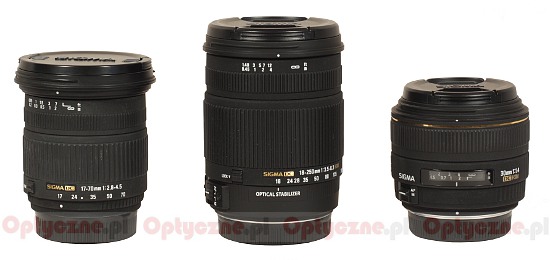 |
Please Support UsIf you enjoy our reviews and articles, and you want us to continue our work please, support our website by donating through PayPal. The funds are going to be used for paying our editorial team, renting servers, and equipping our testing studio; only that way we will be able to continue providing you interesting content for free. |
- - - - - - - - - - - - - - - - - - - - - - - - - - - - - - - - - - - - - - - - - - - - - - - -
The Sigma 18–250 mm OS, like all lenses of this producer, is made in Japan and it starts with a metal bayonet mount. Inside, you can find a rear element which is only 18 mm in diameter and is positioned on the same level as the mount with the focal length is set at 18 mm. When we pass to 250 mm the element hides over 6 cm deep inside the barrel, revealing well blackened interior of the lens.
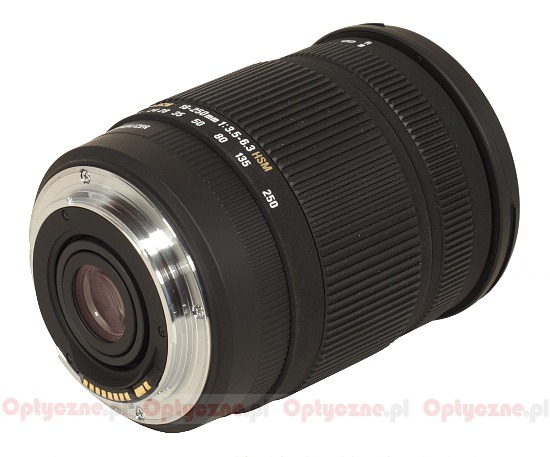 |
Already on the proper barrel we find a smooth part of the casing with the inscription “OPTICAL STABILIZER”. On the left there are focusing mechanism mode switches (AF/M) and the stabilization switch (OS ON/OFF). The other part of the barrel is occupied by a 48 mm wide zoom ring with rubber ribbing taking its biggest part – it enables an easier grip and more comfortable work. Below the ribs we see the name and parameters of the lens and under them focal length markings for 18, 24, 28, 35, 50, 80, 135 and 250 mm. On the left side we also get a LOCK button which blocks the lens at 18 mm. It is useful only occasionally because in the folded position, pointed downwards, the lens doesn’t have any zoom creep tendency. Such tendency appears in the middle of the focal lengths’ range but only after directing the system of front elements downwards and shacking slightly the whole device. The zoom ring doesn’t work very smoothly – you can feel bigger resistance in the 28-135 mm range and lesser at other focal lengths.
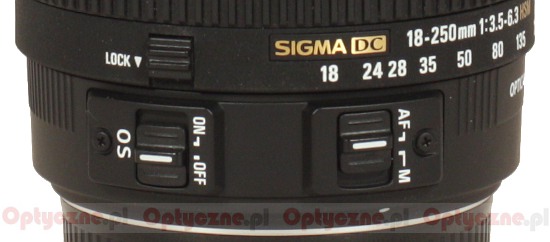 |
In the other part of the lens we get a manual focus ring. Ribbing takes more or less a half of it with distance scale, expressed in meters and feet, right below. You can move the ring only in the MF mode and it works with too much slack. It would be difficult to speak about any precise settings here because running through the whole scale takes a turn through about 70 degrees – really not much.
The front element of the lens is 5.5 cm in diameter and surrounded by the inscription with the name of the instrument and the information that it was produced in Japan. There is also a non-rotating filter thread with a diameter of 72 mm.
When you pass from 18 mm to 250 mm the front element extends on a telescopic plastic tube. Because of that the dimensions of the lens increase by 7.5 cm.
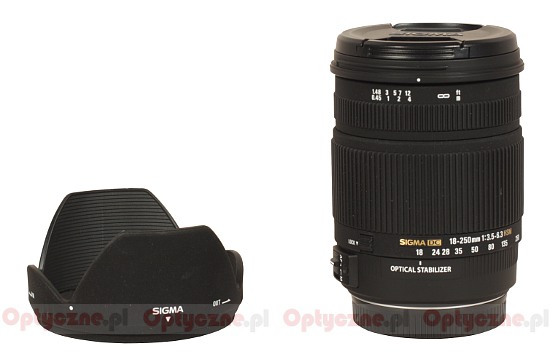 |
The buyer gets both caps and a petal-type lens hood. The lens comes with a two-year warranty period with a payable option of extending it by an additional year.
Stabilization
Traditionally the producer boasts of optical stabilization as efficient as 4 EV. Also traditionally we check whether such a declaration is true. In order to do so we took several photos of every exposure value ranging from 1/320 to 1/4 of a second with the stabilization switched on and off. The focal length was set at 250 mm. The result as the percentage of blurred photos is presented below (the 0 EV point corresponds to 1/250 of a second).
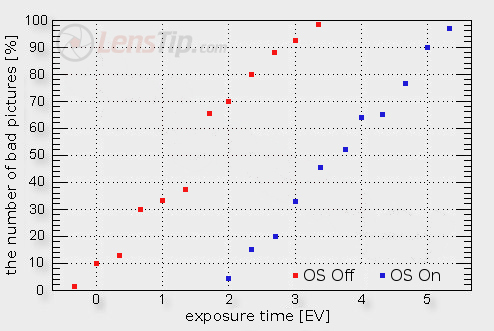
The maximum distance between both curves reaches 2.3-2.5 EV and such is the stabilization efficiency of the tested Sigma. A result undoubtedly decent but not especially impressive.
One more thing at the end, which might be connected with the presence of a movable element of the optical stabilization. It happened several times when we started using the Sigma 18-250 mm OS - immediately after switching the camera on and the initial releasing of the shutter, the image in the viewfinder jumped vertically even by 1/4 of a frame. What’s interesting it was observed no matter whether the OS switch was in ON or OFF position. It didn’t have any negative influence apart from the fact that sometimes we had to reset the camera, which was ready and pointed at the testing chart, to a bit different position.






